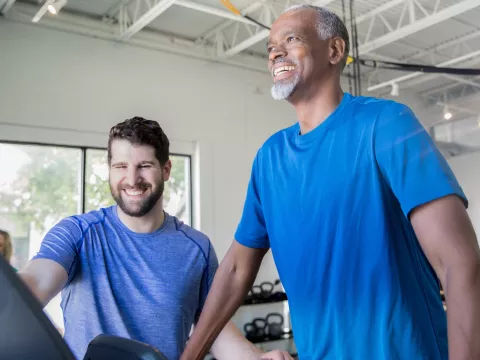- AdventHealth

Sports-related injuries can happen to anyone — from the most skilled Tampa Bay Lightning athlete to the fan who enjoys a pick-up game of basketball every now and again.
When an injury does happen on or off the ice, it’s important to have a trusted healthcare partner by your side to treat your injury and nurture you back to whole health.
As the official health and wellness partner of the Tampa Bay Lightning, we’re here for you, Lightning fans, just as we are your favorite Lightning players.
So, here are a few common sports injuries that are important to know about, as well as how to help prevent them.
6 Common Sports Injuries
Muscle or Tendon Strain
Strains happen if you overstretch or tear a muscle or tendon, which attaches muscle to bone. Symptoms can include muscle spasms, pain, swelling and limited range of motion.
Ligament Sprains
Sprains can be confused with strains, but they differ in that they are injuries to ligaments. Ligaments are tissues in joints that connect bones to one another. Symptoms of a sprain are similar to a strain, except sprains can cause bruising and don’t usually cause muscle cramps like strains do.
Achilles Tendon Injuries
The Achilles tendon is located on the backside of your ankle. It can break or rupture while doing physical activity, causing severe pain and trouble walking. Sometimes, people report hearing a “pop” when the Achilles tendon ruptures. An Achilles tendon tear can require surgery to repair.
Rotator Cuff Injury
Your rotator cuff is made up of four different muscles that allow your shoulder to have complete range of motion. Any sport that involves repetitive shoulder movements, such as hockey, baseball, basketball and golf, can cause a muscle tear that affects the rotator cuff. More extensive rotator cuff injuries may require surgery.
Knee Injuries
Your knee takes the brunt of a lot of wear and tear, so it’s a common source of sports injury. Knee injuries can include fractures, dislocations, sprains and ligament tears, like the ACL (anterior cruciate ligament). The ACL connects your thighbone to your shinbone and stabilizes the knee.
Injuries to the ACL are common and caused by sudden movements like stops or changing direction quickly. This injury can cause severe pain, trouble walking, swelling and the feeling of instability. Treatment for an ACL tear can include rest, surgery and physical therapy.
Broken Bones
Broken bones, or fractures, can happen from a fall, collision or even stress due to overuse in sports. Bone injuries can vary from minor to severe, requiring emergency medical attention. It’s important to see a doctor for any bone injury to get a proper diagnosis and treatment plan. This is especially true for young athletes whose bones are still developing.
We have some extra tips on how to prevent and heal stress fractures here.
Back Injuries
Sports activities can lead to back muscle strains or ligament sprains. In more serious cases, a fall or contact sport can lead to spine fractures, disc injuries or trauma that requires immediate critical care. In these cases, it’s important to dial 911 and stay still until emergency medical care can evaluate your injury.
Here are some helpful tips on strengthening your spine to prevent injuries.
How to Treat Sports Injuries
Mild sprains and strains might just need some TLC and rest. In fact, many respond well to the RICE method. RICE stands for:
Rest: Avoid using the affected joint or injured area so that it can heal.
Ice: To help reduce swelling and inflammation, ice your injured area for 20 minutes, and then leave the ice off for 20 minutes. Repeat this as much as possible for the first 24 to 48 hours after your injury.
Compression: Wrapping the affected joint in a bandage can help reduce swelling.
Elevation: Try to keep the affected joint elevated to reduce swelling.
If you’re experiencing any numbness, tingling, trouble walking and inability to move the joint or area injured, seek medical attention immediately.
If you’ve tried the RICE techniques but are still experiencing pain, discomfort or limited function two weeks after your injury, it’s important to see your doctor for an evaluation and help.
Your doctor may recommend some diagnostic tests like an X-ray or MRI. After a diagnosis, your injury may require physical therapy or surgery.
Tips to Prevent Sports Injuries
Some injuries are unavoidable, but there are a few things you can do to keep your body strong so your activities stay safe and fun.
Here are a few tips to consider.
- Stay fit. Condition your body by engaging in regular physical activity. This can improve your muscle strength and joint stability while playing a sport or being active.
- Wear the right gear. Wear properly fitting equipment and gear, such as shoes, helmets, teeth guards, pads, etc.
- Warm up and cool down. Warm up before and cool down after exercise. This helps prepare the muscles to perform.
- Schedule rest days. Allowing your body to rest in between intense exercise or performance provides time for your body to heal and recover.
- Plan for your environment. Think about the weather and conditions. Wear appropriate clothing for your environment and avoid dangerous conditions that could put you in harm’s way, like ice, storms or other dangers.
Staying fit, healthy and active is an important part of living a full life — and being the best Lightning fan. If you need help to achieve your peak performance or bounce back healthy and strong after a sports injury, turn to our Physical Therapy and Rehab Care for help.



